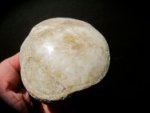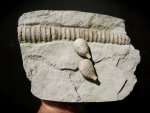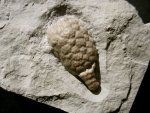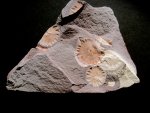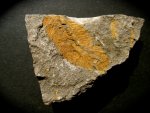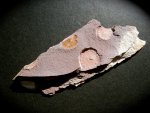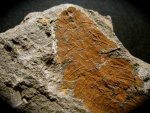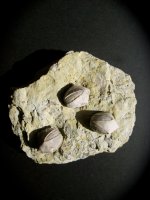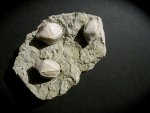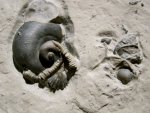 Other
Fossils for
Sale
Other
Fossils for
Sale
Other Fossils for Sale: Page 1
Agatized Camarocrinus Crinoid Bulb Fossil Oddity from Oklahoma |
Name: Camarocrinus
ulrichi
Age: Devonian Size: The bulb is 3 5/8 in diameter, an 2 ¾” in length. Fossil Location: Haragan Formation, Arbuckle Mountains, Ada, Ollahoma Comments: A true fossil oddity, not unlike petrified wood. The interior of the crinoid bulb filled in with minerals and became agatized over the eons. These crinoids were attached to the bottom of the sea and this was the flotation bulb. Price: $60.00 - Code PFO514 - Free postage in the USA - Purchase |
Silurian Dawsonoceras Nautauloid & Holocystites Cystoid Fossils Association |
Name: Dawsonoceras annulatum (nautauloid) Holocystites scutellatus
(cystoid) |
Excellent Holocystites Silurian Cystoid Fossil |
Name: Holocystites
scutellatus (cystoid) |
Early Soft-Bodied Ediacaran Porpita porpita Fossils from Australia |
Name:
Porpita porpita They
bear a striking resemblance to the extant pelagic cnidarian
porpita (or blue button). The Ediacaran biota include the
oldest definite multicellular organisms with tissues, and
the most
common types resemble segmented worms, fronds, disks, or
immobile bags. They bear little resemblance to modern lifeforms,
and
their relationship even with the later life forms of the
Cambrian explosion is difficult to interpret. The evolutionary
divergence
of cnidarian and bilaterian lineages from their remote metazoan
ancestor occurred at an unknown depth in time before the
Cambrian, since crown group representatives of each are found
in Lower
Cambrian fossil assemblages. The multicellular cnidarians
evolved early on earth and despite their primitive nature
have endured
for hundreds of million of years since. It remains uncertain
whether bilaterians evolved from early cnidarians or from
the hypothesized triploblastic ancestors of cnidarians. These
fossils
are very rare and have been legally collected. |
Rare Plumulites Annelid Feathery Worm Fossil |
Name:
Plumulites |
Early Soft-Bodied Ediacaran Porpita porpita Fossils from Australia |
Name:
Porpita porpita They
bear a striking resemblance to the extant pelagic cnidarian
porpita (or blue button). The Ediacaran biota include the
oldest
definite multicellular
organisms with tissues, and the most common types resemble segmented
worms, fronds, disks, or immobile bags. They bear little resemblance
to modern lifeforms, and their relationship even with the later life
forms of the Cambrian explosion is difficult to interpret. The evolutionary
divergence of cnidarian and bilaterian lineages from their remote metazoan
ancestor occurred at an unknown depth in time before the Cambrian,
since crown group representatives of each are found in Lower
Cambrian fossil
assemblages. The multicellular cnidarians evolved early on earth and
despite their primitive nature have endured for hundreds of million
of years since. It remains uncertain whether bilaterians
evolved from early
cnidarians or from the hypothesized triploblastic ancestors of cnidarians.
These fossils are very rare and have been legally collected. |
Rare Plumulites Annelid Feathery Worm Fossil |
Name:
Plumulites |
Pentremites Blastoid Echinoderm Fossils |
Name:
Pentremites pyramidatus |
Pentremites Blastoid Echinoderm Fossils |
Name:
Pentremites pyramidatus |
Waldron Shale Silurian Fossil Association - Platyostoma, Cornulites, Resserella and Craspedia |
Name:
Platyostoma, Cornulites, Resserella, Craspedia |
Agatized Camarocrinus Crinoid Bulb Fossil Oddity from Oklahoma |
Name:
Camarocrinus ulrichi
Age: Devonian Size: The bulb is 3 ¾” in diameter, an 3 3/8” in length. Fossil Location: Haragan Formation, Arbuckle Mountains, Ada, Ollahoma Comments: A true fossil oddity, not unlike petrified wood. The interior of the crinoid bulb filled in with minerals and became agatized over the eons. These crinoids were attached to the bottom of the sea and this was the flotation bulb. Price: $70.00 - Code PFO513 - Free postage in the USA - Purchase |
|
